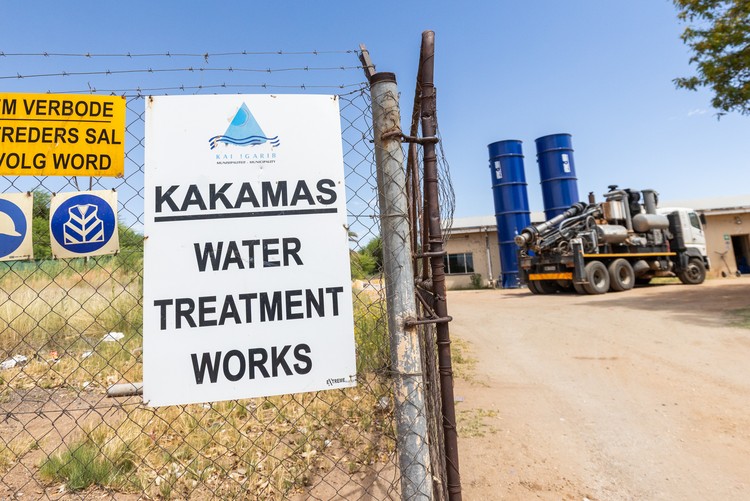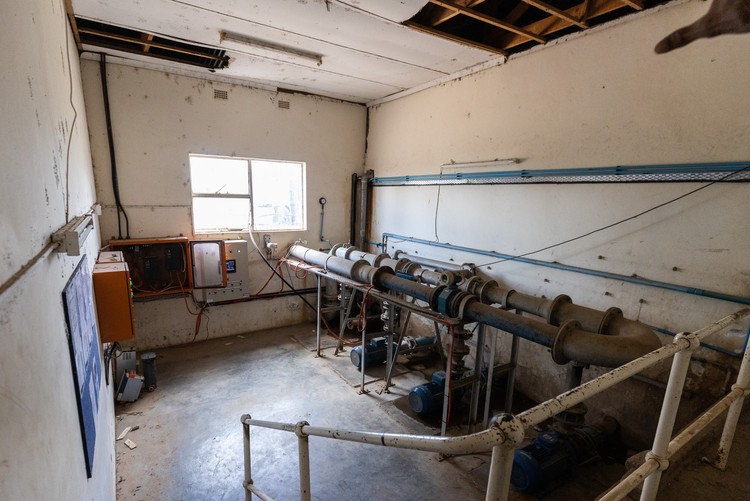Augrabies is known for its gushing waterfall, but communities struggle to get clean water
Department of Water intervenes as Kai !Garib battles frequent water interruptions, infrastructure failures and dirty tap water
The entry into the Kakamas water treatment works in the Northern Cape’s Kai !Garib municipality. The Department of Water and Sanitation has now stepped in to help. Photos: Ashraf Hendricks
- Water purification infrastructure in Kai !Garib municipality in the Northern Cape has been failing, due to ageing infrastructure, lack of staff and financial troubles.
- The area has consequently had frequent water disruptions and dirty tap water.
- The Department of Water and Sanitation has stepped in to help, and is considering legal action against the municipality for failing to comply with a 2022 directive.
For nearly ten years, communities in the Kai !Garib region of the Northern Cape have been plagued by frequent water shortages and dirty tap water as infrastructure crumbles.
Three of the region’s largest towns are Kakamas, Keimoes and Kenhardt. It is also the location of the Augrabies Falls National Park. The area is semi-arid, on the banks of the Orange River, where the municipality extracts water. However, the municipality has failed to fix its water purification infrastructure because of financial troubles.
The Department of Water and Sanitation (DWS) publishes occasional assessments on drinking water quality and water infrastructure in municipalities across the country.
Over the past few years, the department conducted “numerous investigations” of the municipality and the Kakamas Water Treatment Works (WTW). The department issued a directive in 2022 for the municipality to improve its water quality and for the municipality to timeously advise its residents when the water is not safe for drinking.
In 2023 Kai !Garib’s Blue Drop Score dropped from 71% in 2014 to just 16%. This is far below the “critical risk” target of 31%. All 16 of its water supply systems had high or critical risk ratings.
The Department has since intervened in the crisis.
DWS Director-General Sean Phillips, in a letter in May, attributed the municipality’s regular water supply shortages to staffing issues, failing infrastructure, and financial troubles.
“There has been little to no response from the Kai !Garib local municipality… The department is therefore considering legal action in this regard,” wrote Phillips.
According to the municipality’s 2022/2023 annual report, the water purification systems can’t meet the growing demand of the towns.
“The Water Treatment Plant in Kakamas is of such a nature that it may fail at any time and this will have devastating effects on the community and the municipality,” the report read, adding that the plant was beyond its lifespan.
The municipality acknowledged that despite the water treatment plants running at full capacity, “all of the settlements within the municipality still have limited or no access to clean drinking water”.
Kakamas community leader Leonard Mckay told GroundUp that in recent months, several towns have frequently had no running water. And when the water does run, it appears to be brown and dirty.
Mckay said he has tried to raise the community’s concerns about the water crisis to the department and the Human Rights Commission.
Inside one of the rooms at the water treatment works facility.
Maintenance failures
In 2022, a municipal technical report indicated that the last upgrade to the Kakamas plant was in 1987. Building, mechanical equipment, and dosing equipment is “in a very poor condition”, the report stated. Chlorine dosing is “done by hand” and there is “urgent repair work needed”.
When GroundUp visited the plant at the end of 2024, the building was falling into disrepair and the chlorine had run out.
The department funded nearly R13-million, through the Water Supply Infrastructure Grant (WSIG), for emergency repairs to the Kakamas WTW. But the department has admitted delays to the project because the municipality had used the funding “for operational purposes”. (It’s unclear what this means.)
Department spokesperson Wisane Mavasa told GroundUp that funding will be prioritised to complete the WTW in this financial year.
In their annual report, the municipality notes that a feasibility study calculated the cost of a new plant would be about R80-million.
The Department estimates that the project to upgrade water infrastructure in Kakamas, Alheit, Marchand, Augrabies, Lutzburg, Cillie, and Riemvasmaak will cost over R300-million.
In the meanwhile, drinking water quality issues will continue until the water projects are completed, said the DWS.
Kai !Garib also returned unspent R13.9-million allocated via a municipal infrastructure grant to the National Treasury at the end June 2024, according to audited financial statements.
The problem is not unique to Kai !Garib and it is widespread across the Northern Cape. In a recent parliamentary response, Minister of Cooperative Governance and Traditional Affairs Velenkosini Hlabisa said he was “aware that Northern Cape municipalities have been struggling to spend their municipal infrastructure grant allocations and that some have used their conditional grants to pay operational expenses”.
The minister said that Northern Cape municipalities struggled to spend their grants due to “failure to procure services on time”, using conditional grants for operational expenses, poor planning, and failure to appoint competent managers.
The Kai !Garib municipality didn’t respond to GroundUp’s repeated requests for comment. We also reached out to the ZF Mgcawu District Municipality who committed to respond but did not by the time of publication.
Support independent journalism
Donate using Payfast

Don't miss out on the latest news
We respect your privacy, and promise we won't spam you.
Next: After five months, silence on murder of Imam Muhsin Hendricks
Previous: Immigrant families left homeless after eviction from army land in Marievale
© 2025 GroundUp. This article is licensed under a Creative Commons Attribution-NoDerivatives 4.0 International License.
You may republish this article, so long as you credit the authors and GroundUp, and do not change the text. Please include a link back to the original article.
We put an invisible pixel in the article so that we can count traffic to republishers. All analytics tools are solely on our servers. We do not give our logs to any third party. Logs are deleted after two weeks. We do not use any IP address identifying information except to count regional traffic. We are solely interested in counting hits, not tracking users. If you republish, please do not delete the invisible pixel.


